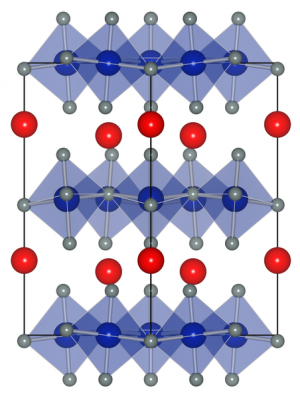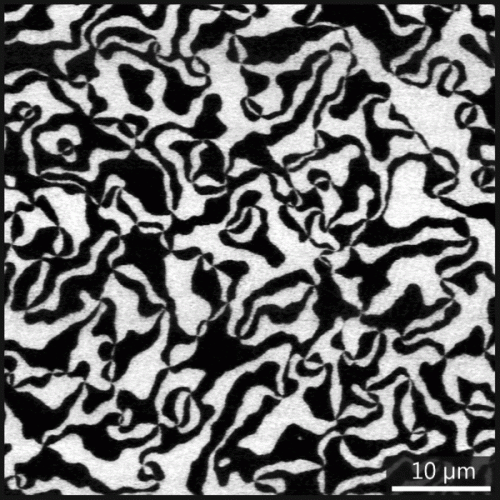Structure of the yttrium manganite crystal. The figure shows the atomic unit cell from which the investigated crystals are composed. Manganese atoms (blue) are placed within a cage of oxygen atoms (gray). In between these the yttrium atoms (red) are arranged. The slight tilt of the oxygen cages to the left or right is the basis of the phase transition described in the text.
(Phys.org)—Scientists have replaced the telescope with the microscope: Using the similarities between the structure of a crystal and the state of the cosmos in the early universe, they have explored a yet unconfirmed phenomenon, the formation of cosmic strings. These so-called "topological defects" are believed to have formed as the universe expanded shortly after the Big Bang.
Studying the formation and early development of the universe is difficult as neither can be recreated in the laboratory. Instead, cosmologists and astrophysicists depend on gigantic telescopes orbiting in space. With these they observe the cosmic microwave radiation, which is a kind of echo of the Big Bang and can reveal important information about early universe processes. But recently materials scientists have entered the field of cosmology and gained new insights using more simple earth-based supercomputers and microscopes. This is the case with Nicola Spaldin, Professor for Materials Theory and Manfred Fiebig, Professor for Multifunctional Ferroic Materials at the ETHZ.
Parallels between a crystal and the universe
Spaldin and Fiebig, together with their research groups, have tackled a fundamental question of cosmology using a small crystal of a material called yttrium manganite. The crystal first attracted the researchers' attention because of its so-called multiferroic behavior, in which the electric charges and magnetic dipoles arrange themselves spontaneously. The scientists discovered that, very surprisingly, the spontaneous arrangement of the electric charges follows the same rules that describe the universe during its early expansion – in fact at the time when the universe split into matter and the forces keeping it together.
Regions with different orientation of the electric charges in yttrium manganite (white and black areas correspond to a positiver and negative charge distribution, respectively). The star-shaped intersections where bright and dark regions meet are the defects corresponding to the cosmic strings.
During the first fraction of a second after the Big Bang, the universe is thought to have experienced a phase transition, in which its state – in particular its symmetry – changed fundamentally. According to cosmology theory this led to the emergence of defects, called cosmic strings (see also), in the otherwise uniform structure of the universe. Cosmic strings have not been observed to date, but a basic law has been developed by physicists Thomas Kibble and Wojciech Zurek to predict how many of them should form under certain conditions. Verification of this "Kibble-Zurek" law is a long sought-after goal, as it would clarify our understanding of the formation of the universe.
The ETH researchers claim the first ever verification of the Kibble-Zurek law for the formation of cosmic strings by exploiting parallels between the symmetry properties of the early universe and their yttrium manganite crystals. "The underlying physical models are applicable to all phase transitions of the same symmetry type", says Spaldin. So once the researchers had shown that yttrium manganite has the same symmetry properties as the early universe, they could calculate the density of defects expected from the Kibble-Zurek law using the CSCS supercomputer "Monte Rosa".
Then they induced the crystallographic phase transition in the laboratory by cooling the crystal, and tested the Kibble-Zurek law by counting the number of defects that formed in the crystal lattice using an atomic force microscope. "The abstract cosmic strings correspond to starlike crossing points in the crystal structure – one can simply count them", Martin Lilienblum, a PhD student in Fiebig's group, happily says.
Crystallographic equivalent to cosmic strings
The researchers found that the number of defects formed experimentally is consistent with the number predicted using the Kibble-Zurek law. "Now that we've demonstrated the validity of the Kibble-Zurek law in yttrium manganite, we can go on to investigate alternative scenarios for the time after the Big Bang", explains Sinéad Griffin, PhD student in Spaldin's group, excitedly "like the possibility suspected by some scientists that the universe expanded much faster than generally believed."
Many other research teams had previously attempted to verify the Kibble-Zurek law in a wide range of systems. "It took a combination of detailed materials theory, crystal analysis, and a lot of luck, that allowed us to succeed with yttrium manganite", Spaldin and Fiebig say. "It is fantastic that we are all working in the same department at the ETH Zurich", where they continue their research on "cosmology under the microscope."
More information: Griffin, SM et al. Scaling behavior and beyond equilibrium in the hexagonal manganites, Physical Review X 2, 041022 (2012) DOI: 10.1103/PhysRevX.2.041022.
Journal information: Physical Review X
Provided by ETH Zurich
























